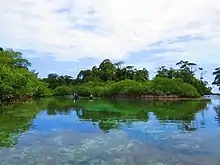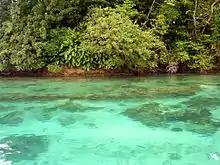


Isla Escudo de Veraguas is a small (4.3 km2) isolated Caribbean island of the Republic of Panama. Despite its name, it is not part of the province of Veraguas, but rather Bocas del Toro. Although located only 17 km from the coastline in the Golfo de los Mosquitos and isolated for only about 9000 years, several animals found on the island are distinct from their mainland counterparts, and two mammal species or subspecies are recognized as occurring only on the island: the fruit bat Dermanura watsoni incomitata and the sloth Bradypus pygmaeus (also known as the pygmy sloth). These two taxa and the worm salamander Oedipina maritima are all considered to be critically endangered due to their being unique to the small island.[1] Other mammals found on the island include the bats Glossophaga soricina, Micronycteris megalotis, Carollia brevicauda, Myotis riparius, and Saccopteryx leptura, the spiny rat Hoplomys gymnurus,[2] and the opossum Caluromys derbianus.[3] The island has 26.36 acres (10.67 ha) of mangrove forest (the only known habitat of the pygmy sloth) and 247 acres (100 ha) of coral reef with 55 coral species. It houses over 11,000 species, such as the pygmy sloth. The island has an average high temperature of 23 degrees Celsius and a low temperature of 12 degrees Celsius.
Escudo de Veraguas is traditionally considered the birthplace of the Ngöbe–Buglé people. Until 1995 the island remained largely unpopulated, but since that time Ngöbe–Buglé fishermen from nearby coastal towns moved in, first using the island as a base for fishing parties and later settling permanently. In 2012, about 120 fishermen and their families were settled on the island.
Escudo de Veraguas, an island renowned for its abundant forests and clear waters, is located about an hour away from Rio Caña, an Indigenous Ngäbe Buglé community that is part of a recently established tourism network in Panama. This island is the exclusive destination where tourists have the opportunity to encounter the elusive three-toed pygmy sloth.
References
- ↑ Kalko and Handley, 1994; Anderson and Handley, 2001
- ↑ Handley, C.O. (1959). "A review of the genus Hoplomys (thick-spined rats), with description of a new form from Isla Escudo de Veraguas, Panama". Smithsonian Miscellaneous Collections. Smithsonian Institution. 139 (4): 1–10. hdl:10088/22959. OCLC 906190284.
- ↑ Kalko and Handley, 1994, p. 270
Literature cited
- Anderson, R. P.; Handley, C. O. Jr (2001-04-19). "A new species of three-toed sloth (Mammalia: Xenarthra) from Panama, with a review of the genus Bradypus" (PDF). Proceedings of the Biological Society of Washington. 114 (1): 1–33. Archived from the original (PDF) on 2010-06-13. Retrieved 2010-12-12.
- Anderson, R. P.; Handley, C. O. Jr (May 2002). "Dwarfism in insular sloths: biogeography, selection, and evolutionary rate". Evolution. 56 (5): 1045–1058. doi:10.1111/j.0014-3820.2002.tb01415.x. PMID 12093018.
- Kalko, E. K. V.; Handley, C. E. (1994). "Evolution, biogeography, and description of a new species of fruit-eating bat, genus Artibeus Leach (1821), from Panamá". Zeitschrift für Säugetierkunde. 59 (5): 257–273. Retrieved 2010-12-12.
9°05′51″N 81°33′29″W / 9.09750°N 81.55806°W